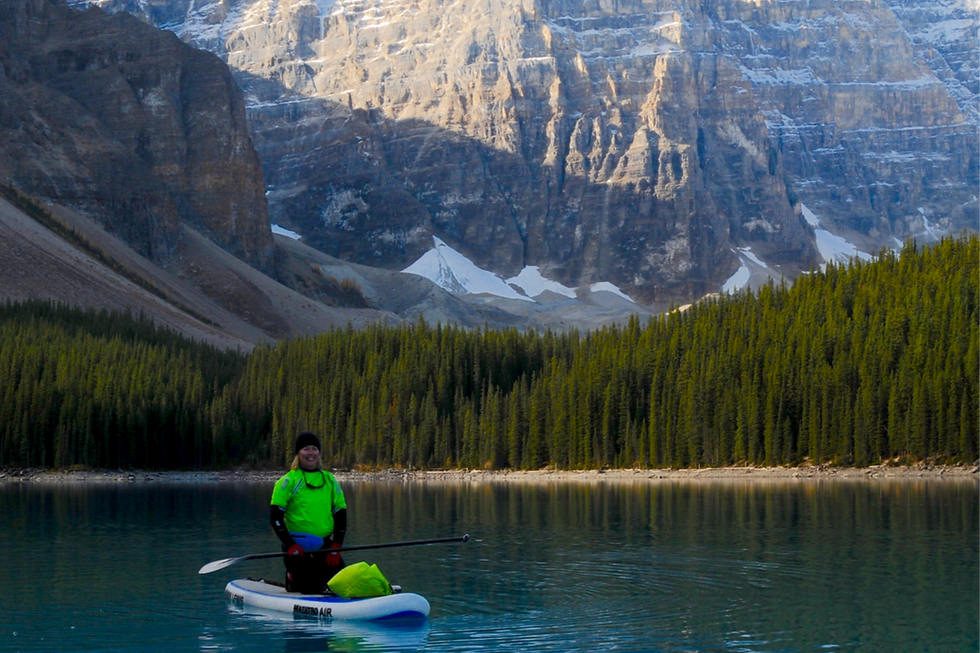The Ultimate Guide to Inflatable versus Hard Paddleboards
- Pam Martin

- Jun 3, 2021
- 4 min read
Updated: Oct 29, 2022
Have you been struggling to decide between getting an inflatable versus a hard Stand Up Paddleboard? You are not alone! The inflatable vs hardboard question is our number 1 most frequently asked question at Blue Jellyfish SUP Adventures and we are here to help.
Left: Hardboards, Centre: Inflatables, Right: Inflatables & a Hardboard
First, let’s review what the terms ‘inflatable paddleboard’ and ‘hardboard’ mean;
An inflatable paddleboard, inflatable SUP, or iSUP are usually made of PVC and are similar to an inflatable kayak or river raft.
A hardboard, solid SUP, rigid paddleboard or hard paddleboard are paddleboards made of wood or foam, covered with fibreglass or epoxy resin making them hard. Hard boards may also be created from carbon. These boards are very closely related to surfboards.
When you are looking to purchase a stand-up paddleboard, there are five factors to consider when deciding between an inflatable and a hardboard:
Portability
Storage space
Durability
Performance
Ease of use
Let’s look at each factor in turn and see how the two board types compare;
Inflatables pumped and ready to paddle!
SUP Portability
Inflatable SUP’s are easy to transport. You don't need a vehicle with a roof rack because when these boards are deflated they roll up into a convenient carry backpack that fits in your car. This makes them easy to take on any adventure, even on an airplane.
With a hardboard, you'll need a vehicle with a roof rack or a truck that can transport a large piece of gear. You will need to be comfortable lifting the board on and off of your roof.
Storage Space
The area you have to store your boards may be a deciding factor between the two options.
With hardboards, you'll need ample storage space that's at least the length of your board. Hardboards can be stored on racks outside but need to be protected from the sun.
For inflatables, all you need is room for the hundred-litre backpack which can be left in a corner of your office or even stuffed in a closet. Many people don’t realize that you can store your boards inflated, out of the sun. Be sure to top up the air each time you go for a paddle and release a bit if you are travelling with your inflatable on your rooftop.
Durability
High-quality inflatables are constructed with 2-3 layers of durable PVC material that can withstand daily abuse, drops and rocky beach landings. Great for kids! If they happen to puncture while paddling though, they are difficult to repair without glue, patches and your pump.
Hardboards are made of fibreglass and epoxy resin layers over hollow wood or foam cores, or in some cases carbon fibre. While also strong and reliable they must be treated with the utmost care the same way you'd handle a traditional surfboard. No drops or rocky beach landings for these boards. If dinged while on a paddle they are easily temporarily fixed with some duct tape or your favourite brands sticker.
SUP Performance
Hardboards have more glide and less drag than inflatables but the difference is smaller than what you might think. An epoxy board will be about 5% faster than an inflatable so unless you plan to cover long distances or race with your board you probably won't notice the difference.
Inflatables tend to be more wind-affected since they are lighter and often sit higher above the water.
Ease of Use
Hardboards have no setup. Once you get to your destination, you just grab your board off the roof and go. They may be awkward to lift on and off of your roof on your own without bumping them, but there are techniques that will make this easier or you can recruit your paddling buddy to help out.
With an inflatable, you'll need to unpack and inflate your board to the proper psi and put on the fins before getting on the water. This is a 10-15 min process that will definitely have you warmed up before you get on the water. An electric pump connected to your car will take the same amount of time but save your muscle power for the water.
Which is the right board for you?
An inflatable paddleboard will be ideal for you if:
You have minimal storage
You hate loading outdoor gear on your vehicle roof
You plan to travel and want to take your board with you
You're an adventurous paddler who needs a durable board to withstand daily abuse
You don’t want to have to worry about rocks, docks and other hard objects
You don’t mind a 10-15 min set up prior to paddling
You would rather patch your board with glue and PVC
Inflatable SUP’s in Canada we like: Red, Starboard, Cascadia, Bluwave, & iRocker Paddleboards
A hard paddleboard will be ideal for you if:
You have 10-15 linear feet of easy to access storage space
You have a big vehicle and/or a roof rack and are able to load your board solo or always Paddle with a buddy who will help
You want optimal performance like agility and speed when paddling
You want to go surfing or compete in paddleboard races
You are paddler who doesn't want to set anything up after you arrive at your paddling destination
You are content to do fibreglass work for repairing your board
Hard SUP boards available in Canada we like: Starboard, Sunova, ONE SUP, Boardworks, Jimmy Lewis, Cascadia
Share with us in the comments - which board type sounds right for you? Still confused?
Contact us if you have more questions.


















Comments